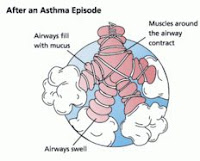 Two major endotypes for asthma have been described:
Two major endotypes for asthma have been described:- TH2-high, manifested by increased eosinophils in the sputum and airways of patients
- TH2-low, with increased neutrophils or a pauci-granulocytic profile
This review article evaluated human clinical trials using biologics for T-helper type 2 cell (TH2)-low and TH2-high asthma.
Multiple immune response modifiers have been evaluated in TH2-high asthma geared at blocking interleukin (IL)-5, IL-13, immunoglobulin E, prostaglandin D2, and other pathways. As of year 2016, 3 immune response modifiers approved by the Food and Drug Administration are available for treating severe TH2-high asthma:
- anti-immunoglobulin E, omalizumab, available for more than 10 years
- anti–IL-5 monoclonal antibodies, mepolizumab (SC) and reslizumab (IV)
Many of the TH2-high therapies have shown better efficacy when certain biomarkers are elevated, especially blood eosinophils. The TH2-low endotype does not have any readily available point-of-care biomarkers, and development of therapies has lagged behind that for TH2-high asthma.
References:
Characterization of asthma endotypes: implications for therapy. Jeffrey R. Stokes et al. Annals of Allergy, Asthma and Immunology, August 2016, Volume 117, Issue 2, Pages 121–125 (free full text).
http://www.annallergy.org/article/S1081-1206(16)30266-6/fulltext
The World Allergy Organization (WAO) Small Airways Working Group publishes a monthly "What's New?" summary and I have served as its editor since 2011. The summary features the top 3 asthma/small airways articles each month. The article above is a part of the project. The archive is here: http://www.worldallergy.org/small_airways_group/reviews/archive.php
Image source: Image source: FDA and Wikipedia, public domain.